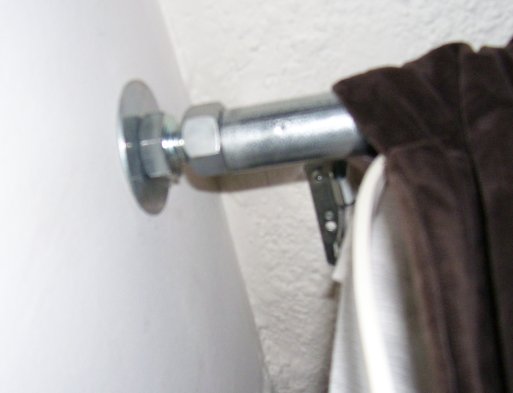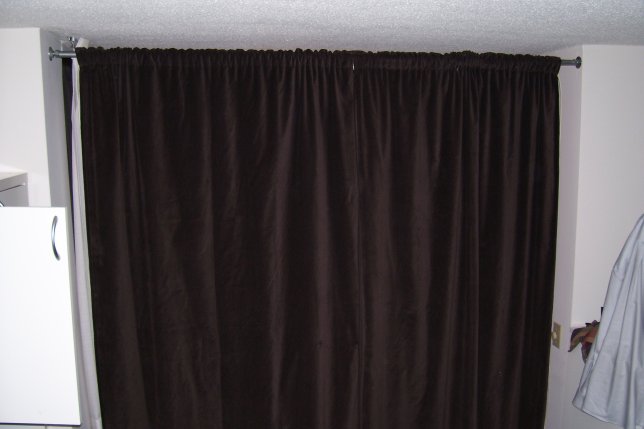How to Make a Tension Rod
This article describes how to build a tension rod that could be used to hold up a curtain going from one wall to another wall. Typically, store bought rods are either too short (maximum 6 feet) or longer (up to 8 feet) but flimsy plastic with no stability. The overall cost of this rod is less than $15 and takes about 1 to 2 hours to install.
Materials:
- 3/4" thick electrical conduit rod (10' long max)
- 2 x 5/8" bolt (1.5" to 2" long)
- 2 x nuts for the bolts
- 2 x large washers
- tape (masking or scotch)
- 2 wrenches to fit 5/8"
- tube cutter
The washers are taped to the head of the bolts. Once the rod is secure, the tape can be removed. If you don't tape the washers to the bolt heads, then the washers will fall down when you're putting up the rod. The washers are there to distribute the pressure over a larger surface area. You can choose washers, a block of wood, or something else to distribute the pressure. I chose washers because they are thin but rigid and go with the overall look. The longer the rod, the more force required to secure it, and the larger the washer should be. The washers I used were the largest I could find. Note: the hole in the washer should be small, so the bolt head covers it completey. Ideally, there would be no hole, just a flat plate.
Use the tube cutter to cut the rod to the appropriate length. Take into consideration the space required for the washers, bolt heads and nuts. Cut the tube so that once the bolts+nuts+washes are inserted in both ends, you can slide it between the walls with as little play as possible.
If the curtain hooks onto the rod, then you can put it on after. If the curtain slides onto the rod, then you'll have to put the curtain on first, and then secure the rod.
Screw the nuts onto the bolt as far as they will go (hand tightened). Insert the bolts, one into each end of the rod. Then hold the rod in place and unscrew the nut at one end so that it puts enough pressure on the wall to keep the rod up. You might need a friend to hold up one end of the rod, or rig up some system to hold it in place. As the nuts unscrew, they press tight against the rod and that puts pressure on the wall which keeps the rod up. Note: if you unscrew the nuts too far, it could crack your wall. As you unscrew, the washer should not turn at all. You can hold the bolt head inplace using one wrench, and use a second wrench to unscrew the nut.
Once the rod is semi-secure, go to the other end and test how difficult it is to unscrew the nut on that end. You will probably be able to unscrew a little bit more.
Here is the finished product. The picture shows a 7' long tension rod with no noticable sag.
Clean-Up
During the installation, the rod or washers might mark the walls. Fear not! Buy some Mr. Clean Magic Eraser, dip the end in a tiny bit of water, and the marks will rub out like magic.


